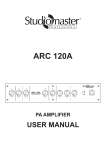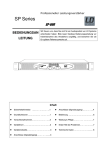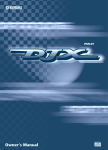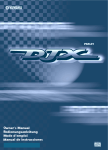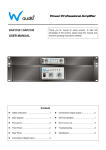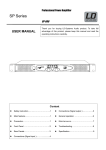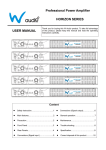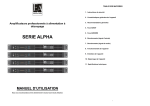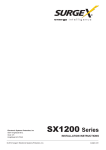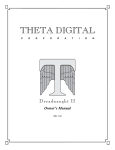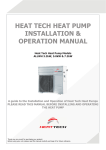Download DPA MANUAL Rev001 08.10.2010
Transcript
R DUAL CHANNEL POWER AMPLIFIERS DPA 2000 DPA 3200 DPA 4500 DPA 5000 Owner’s Manual CH 1 I CH 2 PROTECT -6 -6 -3 -10 -3 -10 CLIP POWER O -15 -1 -30 -80 -15 SIGNAL -1 -30 0dB -80 POWER 0dB Class H Professional Power Amplifier PROTECT POWER CLIP SIGNAL -6 I -6 -3 -10 -3 -10 POWER O CH -15 1 -15 -1 -30 -80 -1 -30 0dB -80 CH 2 Class H Professional Power Amplifier 0dB PROTECT POWER CLIP SIGNAL -6 I -6 -3 -10 -3 -10 POWER O CH -15 1 -15 -1 -30 -80 -1 -30 0dB -80 CH 2 Class H Professional Power Amplifier 0dB PROTECT POWER CLIP SIGNAL -6 I -10 -6 -3 -10 -3 POWER O CH -15 1 -15 -1 -30 -80 0dB -1 -30 -80 0dB CH 2 Class H Professional Power Amplifier Explanation of Graphical Symbols The lightning flash with arrowhead symbol within an equilateral triangle is intended to alert the user to the presence of uninsulated “dangerous voltage” within the product’s enclosure that may be of sufficient magnitude to constitute a risk of electric shock to persons. CAUTION RISK OF ELECTRIC SHOCK DO NOT OPEN CAUTION: TO REDUCE THE RISK OF ELECTRIC SHOCK, DO NOT REMOVE COVER (OR BACK). NO USER-SERVICEABLE PARTS INSIDE. REFER SERVICING TO QUALIFIED SERVICE PERSONNEL. The exclamation point within an equilateral triangle is intended to alert the user to the presence of important operating and maintenance (servicing) instructions in the literature accompanying the product. The above warning is located on the top of the unit IMPORTANT SAFETY INSTRUCTIONS 1 2 3 4 5 6 7 8 Read these instructions. Keep these instructions. Heed all warnings. Follow all instructions. Do not use this apparatus near water. Clean only with dry cloth. Do not block any ventilation openings. Install in accordance with the manufacturer’s instructions. Do not install near any heat sources such as radiators, heat registers, stoves, or other apparatus (including amplifiers) that produce heat. Do not defeat the safety purpose of the polarized or grounding-type plug. 10 Protect the power cord from being walked on or pinched particularly at plugs, convenience receptacles, and the point where they exit from the apparatus. 11 Only use attachments/accessories specified by the manufacturer. 12 13 . Unplug this apparatus during lightning unused for long periods of time. Refer all servicing to qualified service personnel. Servicing is required when the apparatus has been damaged in any way, such as power supply cord or plug is damaged, liquid has been spilled or objects have fallen into the apparatus, the apparatus has been exposed to rain or moisture, does not operate normally, or has been dropped. 9 2 WARNING TO REDUCE THE RISK OF FIRE OR ELECTRIC SHOCK, DO NOT EXPOSE THIS APPARATUS TO RAIN OR MOISTURE. Precautions — For safe operation — WARNING Installation Do not modify the unit. Doing so is a fire and electrical shock hazard. Connect this unit’s power cord only to an AC outlet of the type stated in this Owner’s Manual or as marked on the unit. Failure to do so is a fire and electrical shock hazard. Do not allow water to enter this unit or allow the unit to become wet. Fire or electrical shock may result. Do not place a container with liquid or small metal objects on top of this unit. Liquid or metal objects inside this unit are a fire and electrical shock hazard. Do not place heavy objects, including this unit, on top of the power cord. A damaged power cord is a fire and electrical shock hazard. In particular, be careful not to place heavy objects on a power cord covered by a carpet. If lightning begins to occur, turn off the power switch of the unit as soon as possible, and unplug the power cable plug from the electrical outlet. Operation Do not scratch, bend, twist, pull, or heat the power cord. A damaged power cord is a fire and electrical shock hazard. Do not remove the unit’s cover. You could receive an electrical shock. If you think internal inspection, maintenance, or repair is necessary, contact your dealer. If there is a possibility of lightning, do not touch the power cable plug if it is still connected. Doing so may be an electrical shock hazard. In case an abnormality occurs during operation If the power cord is damaged (i.e., cut or a bare wire is exposed), ask your dealer for a replacement. Using the unit with a damaged power cord is a fire and electrical shock hazard. Should this unit be dropped or the cabinet be damaged, turn the power switch off, remove the power plug from the AC outlet, and contact your dealer. If you continue using the unit without heeding this instruction, fire or electrical shock may result. If you notice any abnormality, such as smoke, odor, or noise, or if a foreign object or liquid gets inside the unit, turn it off immediately. Remove the power cord from the AC outlet. Consult your dealer for repair. Using the unit in this condition is a fire and electrical shock hazard. CAUTION Installation Keep this unit away from the following locations: - Locations exposed to oil splashes or steam, such as near cooking stoves, humidifiers, etc. - Unstable surfaces, such as a wobbly table or slope. - Locations exposed to excessive heat, such as inside a car with all the windows closed, or places that receive direct sunlight. - Locations subject to excessive humidity or dust accumulation. Do not place the power cord close to a heater. It may melt, causing fire or electrical shock. Hold the power cord plug when disconnecting it from an AC outlet. Never pull the cord. A damaged power cord is a potential fire and electrical shock hazard. Do not touch the power plug with wet hands. Doing so is a potential electrical shock hazard. This unit has ventilation holes at the front, rear & top to prevent the internal temperature rising too high. Do not block them. Blocked ventilation holes are a fire hazard. In particular, do not - place the unit on its side or upside down. - place the unit in any poorly-ventilated location such as a bookcase or closet (other than on the dedicated rack). - cover the unit with a table cloth or place it on a carpet or bed. Allow enough free space around the unit for normal ventilation. This should be: 5 cm at the sides, 10 cm behind, and 10 cm above. If the airflow is not adequate, the unit will heat up inside and may cause a fire. To relocate the unit, turn the power switch off, remove the power plug from the AC outlet, and remove all connecting cables. Damaged cables may cause fire or electrical shock. Operation Use only thick speaker cables when connecting speakers to amplifier outputs. Use of cables type 40/36 or thicker is recommended for connecting low impedance speakers to avoid power loss in the cables, as heavy current flows through the cables. Using other types of cables is a fire hazard. Turn off all musical instruments, audio equipment, and speakers when connecting to this unit. Use the correct connecting cables and connect as specified. Always lower the volume control to minimum before turning on the power to this unit. A sudden blast of sound may damage your hearing. Do not use this amplifier for any purpose other than driving loudspeakers. If you know you will not use this unit for a long period of time, such as when going on vacation, remove the power plug from the AC outlet. Leaving it connected is a potential fire hazard. When operating amplifier on a generator, make sure it is switched “OFF” till generator voltages has stabilized & then only switch “ON” amplifier. Be sure of proper impedance of 2/4/8 ohm when used for STEREO/PARALLEL configuration & 4/8 ohm recommended when used in BRIDGE mode. 3 Tips for Safe Operation The 3 core AC mains cable should be terminated with this AC mains plug by connecting brown/red wire on live pin (L), black/blue wire on neutral pin (N) and yellow/green wire on earth pin (E). For 2 ohm/4 ohm applications, it is recommended to use speakon connectors only. Use of cable 40/36 or thicker is recommended to prevent power losses. The amplifier must be connected to an AC earthed mains outlet that can delivered the maximum power required. The use of extension cables or adaptors should be avoided as this can jeoparadize correct power delivery to the amplifier. The level of input signal should not exceed the specified input sensitivities. Excessive input signal levels result in over driving of input circuit which leads to saturated / distorted output at speaker terminals. All connections must only be carried out or changed with the amplifier switched OFF. Ensure proper impedance matching while in use for BRIDGE mode applications. For continuous safe operation, resultant impedance of the speakers 8 ohm/4 ohm is recommended. Do not operate the amplifier with continuously blinking CLIP LED. The respective volume control of the channels must be adjusted so that the output level does not clip and distort. Do not obstruct the front or back of the amplifier for necessary intake of air. 4 Contents Page No. Features / General Description of Product....................................................................6 Front Panel Controls & Features...................................................................................7 Rear Panel Controls & Features....................................................................................8 Input-Output Connections...........................................................................................10 Setup & Operations.....................................................................................................11 Typical Applications....................................................................................................14 Protections & Installations..........................................................................................17 Trouble Shooting.........................................................................................................18 Specifications..............................................................................................................20 Notes............................................................................................................................23 5 Thank you for your purchase of the STUDIOMASTER DPA Series power amplifiers. These amplifiers fully incorporate STUDIOMASTER’s renowned technology and offers high reliability, rock solid stability and superb acoustic characteristics. *Please retain original packing should you have to return the unit for the repairs. Features / General Description of Product Rugged 19” rack mountable design of chassis. High current torroidal transformer which provides excellent regulation and minimized hum & noise. Low THD and high damping factor for excellent sound quality. Extensive protection circuitry for Overheat, Overload, DC, Output short circuit. Indicator LEDs for Signal, Clip, Protect, Power ON, Mode Selection. Output termination on 4 way speakon Connectors and Binding posts for each channels. Limiter circuit protects the amplifier and speaker from being over driven because of high input level signal. Designed with a sophisticated VHF limiter that reduces the risk of HF stress, and protects your speakers, particularly HF units. Balanced / Unbalanced input signal through parallel XLR in both channels. Slide Switches For 1) Mode selection ( Mono / Stereo / Bridge) 2) Sensitivity ( 0.775 V / 1V / 1.4 V) 3) Low - cut (30Hz) (ON / OFF ) 4) Ground Lift ( GND / LIFT) 5) Limiter 6) HF Limiter Twin tunnel cooling with front to back airflow. This owners Manual covers 4 models, DPA 2000, DPA 3200, DPA 4500 & DPA 5000 power amplifiers. Please read through this manual carefully before beginning use, so that you will be able to take full advantage of amplifier’s superlative features and enjoy trouble free operation for years to come. After reading through the manual, please store it in a safe place. 6 CH 1 I CH 2 PROTECT -6 -6 -3 -10 -3 -10 CLIP POWER -15 O SIGNAL -1 -30 -80 -1 -30 0dB 3 -15 -80 POWER 4 1 4 2 5 6 0dB Class H Professional Power Amplifier 3 5 6 PROTECT POWER CLIP SIGNAL -6 I -6 -3 -10 -3 -10 POWER O CH -15 1 -15 -1 -30 -80 1 6 5 4 3 -1 -30 0dB -80 2 CH 2 Class H Professional Power Amplifier 0dB 3 6 4 5 Front Panel Controls & Features 1 2 3 4 5 6 Master switch Switches the unit on and off, interrupting both phases. Power ON indicator light When lit, this blue LED indicates that amplifier is ON. Volume control Used for adjusting the volume of the channel. Signal indicator Green LED that indicates the presence of the signal in the final stage. It lights up with signals higher than - 20dB. Clip indicator This red LED lights up to indicate that the internal limiter has been activated to eliminate clip. When the limiter is activated, it indicates that the maximum amplification has been reached. When it lights up continuously, this means there is an excessive signal input. Protect indicator Red LED that indicates the mute status of the channel and is lit for the following reasons: switch on delay (3 seconds), presence of continuous voltage on the channel output, short circuit, thermal protection of the channel, thermal protection of the transformer. 7 DPA-2000 2 1 8 10 14 5 3 13 T16A 250VAC 0 9 0 3 0 1 0 8 0 LIMITER 30Hz LOWCUT 9 2 DPA-3200,4500 & 5000 1 2 INPUT GROUND LIFT HF PROTECTION 12 11 15 4 1 8 10 14 9 7 6 5 3 LIMITER 30Hz LOWCUT INPUT GROUND LIFT HF PROTECTION 0 9 0 3 0 1 0 8 0 9 2 1 12 11 15 13 4 9 6 7 Rear Panel Controls & Features 1 Balanced XLR input This XLR connector takes the signal (balanced/unbalanced) for driving the channel. If the signal is unbalanced, pin 2 can be used for the signal and pin 3 connected to the earth. 2 Link Out To Cascade amplifiers. 3 CH 1 output speakon connector Use this connector for picking up the amplified signal of CH 1 and signal for bridged configuration. 4 CH 2 output speakon connector Use this connector for picking up the amplified signal of CH 2. 5 CH 1 output binding post. Use this connector for picking up the amplified signal of CH 1 and signal for bridged configuration. 6 CH 2 output binding post. Use this connector for picking up the amplified signal of CH 2. 7 Power cable Use this cable for supplying power to unit. 8 Configuration switch This three way switch configures the amplifier for the three working modes: parallel, stereo and bridge. 9 Air Outlet grill The air sucked from the front grills is thrown out from these grills. Do not obstruct the grills. The air filter whenever necessary. 8 10 Sensitivity This switch is used to select sensitivity to either 0.775V, 1V or 1.2V depending on the source. 11 Ground lift Allows circuit & chassis grounds to be separated in case of ground loops. 12 Low cut Low cut switch filters the low frequencies from the input signal. Cut off frequency is 30 Hz when it is selected. The filter protects the cone of the speakers against unwanted and inaudible low frequencies. 13 Fuse Mains fuse secures the amplifier & wires against defects, Replace this only with the same type & rating. 14 Limiter This switch activates limiter when in ON position. The limiter prevents distortion of the output level when its gets overloaded. When the output level exceeds its maximum, an internal adjustment will be made to prevent overloading. The limiter is specially designed to safeguard connected full-range speakers. The high tone piezo drivers of these speakers are now protected against distortion and harmonic signals which are the result of over steering the amplifier. When the amplifier is used as a subwoofer amplifier then the limiter has to be switched off to set the extra “punch”. 15 HF Limiter It is a protection for the amplifier against HF. In case there is high amplitude HF signal at the output, it shuts down the amplifier thus protecting the internal circuitry and HF drivers of a speaker system. Presence of prolonged, large amplitude, high frequency output can damage the speakers as well as the internal circuit of the amplifier. The HF limiter circuit continuously monitors the output and shuts down the amplifier, if the high frequency persists for more than 10-15 seconds. The HF limiter has no effect on normal music. 9 Input-Output Connections FIG. 1 BALANCED INPUT CONNECTIONS XLR UNBALANCED INPUT CONNECTIONS XLR FIG. 3 PARALLEL / STEREO OUTPUT CONNECTIONS FIG. 4 BRIDGE OUTPUT CONNECTIONS (CH 1 OUTPUT CONNECTOR) FIG. 5 PARALLEL / STEREO BINDING POST CONNECTIONS FIG. 6 BRIDGE MODE BINDING POST CONNECTIONS -VE OUTPUT +VE OUTPUT +VE OUTPUT -VE OUTPUT 10 FIG. 2 -STEREO -STEREO CH1 OUTBINDING POST CH1 OUTBINDING POST +STEREO/+BRIDGE +VE OUTPUT +STEREO/+BRIDGE +STEREO/-BRIDGE -VE OUTPUT +STEREO/-BRIDGE CH2 OUTBINDING POST CH2 OUTBINDING POST -STEREO -STEREO Setup & Operation Stereo Mode Configuration 0 9 0 3 0 1 0 8 0 LIMITER 30Hz LOWCUT INPUT GROUND LIFT HF PROTECTION SPEAKER SYSTEM (IMP 8Ω / 4Ω / 2Ω) T16A 250VAC SPEAKER SYSTEM (IMP 8Ω / 4Ω / 2Ω) MICROPHONES WIRELESS MICROPHONE SERIES CD PLAYER P A MIXER In STEREO mode, both channels 1 & 2 are fully independent of each other. The balanced / unbalanced inputs can be connected either to a stereo signal source or two independent mono signal sources. Each channel can separately drive loudspeaker loads of 8 ohm or 4 ohm or 2 ohm. Connect the Left and Right outputs of a mixer to a channel 1 and 2 inputs of the amplifier respectively. Inputs can be wired as per fig.1 & 2 (Input Connections for Balanced and Unbalanced Mode) Connect a speaker system (8 ohm / 4 ohm / 2 ohm) on the output terminal of each channel. Either use the speakon connector & wire these as per fig.3 (Output Connections for Stereo / Parallel Mode) or use Binding Post as per wire diagram of fig. 5. To select STEREO mode, keep the slide switch, provided at rear panel, in STEREO position. Adjust the individual volume controls of each channel on the front panel to obtain the desired output level. The level indicator LEDs glow to indicate the presence of signal at the output terminals. 11 Setup & Operation Parallel Mode Configuration 0 9 0 3 0 1 0 8 0 LIMITER 30Hz LOWCUT INPUT GROUND LIFT HF PROTECTION SPEAKER SYSTEM (IMP 8Ω / 4Ω / 2Ω) T16A 250VAC SPEAKER SYSTEM (IMP 8Ω / 4Ω / 2Ω) MICROPHONES ‘Y’- Cable WIRELESS MICROPHONE SERIES CD PLAYER P A MIXER Note:- ‘Y’ cable to be used to make mono cable or use mono output of mixer. When operating in PARALLEL mode, the signal source should be connected to the balanced / unbalanced inputs of channel 1 only. Both channels provide similar outputs to their respective loudspeakers. Each channel can separately drive loudspeaker loads of 8 ohm or 4 ohm or 2 ohm. Connect the line output of a mixer to a channel 1 input of the amplifier. Inputs can be wired as per fig.1 & 2 (Input Connections for Balanced and Unbalanced Mode) Connect a speaker system (8 ohm / 4 ohm / 2 ohm) on the output terminal of each channel. Either use the speakon connector & wire these as per fig.3 (Output Connections for Stereo / Parallel Mode) or use Binding Post as per wire diagram of Fig. 5. 12 TO select PARALLEL mode, keep the slide switch, provided at rear panel in parallel position. The desired output levels for both the channels are adjustable by volume controls of respective channels. The level indicator LEDs glow to indicate the presence of signal at the output terminals. Setup & Operation Bridge Mode Configuration 0 9 0 3 0 1 0 8 0 30Hz LOWCUT INPUT GROUND LIFT HF PROTECTION SPEAKER SYSTEM (IMP 8Ω / 4Ω) T16A 250VAC LIMITER MICROPHONES ‘Y’- Cable WIRELESS MICROPHONE SERIES CD PLAYER P A MIXER Note:- ‘Y’ cable to be used to make mono cable or use mono output of mixer. For BRIDGE mode operation, the signal source should be connected to the balanced / unbalanced inputs of channel 1 only. In this mode, the combined power output of both channels should be connected to a single loudspeaker load. The combined loudspeaker load should not go below 4 ohm. Connect the line output of a mixer to a channel 1 input of the amplifier. Input can be wired as per fig.1 & 2 (Input Connections for Balanced and Unbalanced Mode) To select BRIDGE mode, keep the slide switch, provided at rear panel, in Bridge position and ensure that the bridge LED located on the back panel glows. Connect a speaker system (8 ohm/4 ohm) on the speakon output of channel 1 only. Either use the speakon connectors and wire these as per fig.4 (Output Connections for Bridge Mode) or Binding Post connections as per fig. 6. The desired output levels of both the channels are adjustable by volume control of channel 1 only. The level indicator LEDs glow to indicate the presence of signal at the output terminals. 13 Typical Applications Stereo Mix Plus Subwoofers AMPLIFIER 1 (Stereo Mode) (Fullrange 2/3 way system) (Fullrange 2/3 way system) 30Hz LOWCUT INPUT GROUND LIFT HF PROTECTION T16A 250VAC 0 9 0 3 0 1 0 8 0 LIMITER AMPLIFIER 2 (Bridge Mode) INPUT GROUND LIFT HF PROTECTION T16A 250VAC 0 9 0 3 0 1 0 8 0 LIMITER 30Hz LOWCUT Sub Output Hi Output ACTIVE CROSSOVER Input Sub Output (Subwoofer) 30Hz LOW CUT MICROPHONES WIRELESS MICROPHONE STEREO KEYBOARD SERIES HEADPHONE P A MIXER Connect the left and Right outputs of the Audio mixing console to the respective inputs of the Active Crossover. Connect the Left and Right High frequency output of the active crossover to the respective input channels 1 & 2 of amplifier 1. Inputs can be wired as per fig. 1 & 2 (Input Connections for Balanced and Unbalanced Mode) One number of full range loudspeaker system can be connected to each of the channels of amplifier 1. The output connectors should be wired as per fig. 3 (Output Connections for Stereo / Parallel Mode) for speakon or fig. 5 for Binding Post connections. Amplifier 1 will be used in stereo mode. Keep the slide switch of amplifier 1 in stereo position. Feed the Left low frequency output signal of the crossover to channel 1 input of amplifier 2. Inputs can be wired as per fig. 1 & 2 (Input Connections for Balanced and Unbalanced Mode) 14 The high powered subwoofer system can be connected to the channel 1output of amplifier 2. Output speakon connectors can be wired as per fig. 4 (Output Connections for Bridge Mode) or fig. 6 for Binding Post connections. Amplifier 2 will be used in bridge mode. Keep the slide switch of amplifier 2 to BRIDGE position to activate bridge mode as indicated by the glow of BRIDGE LED, make sure that LOW CUT switch is in OFF position. Finally adjust the volume control of channel 1 & 2 in amplifier 1 to control the level of their respective position to get desired power. Also, adjust the volume control of channel 1 in amplifier 2 to control the levels of their respective position to get desired power. Typical Applications Stereo Mode - Cascade Configuration AMPLIFIER 2 (Stereo Mode) (Resultant Imp = not < 2Ω) (Resultant Imp = not < 2Ω) 30Hz LOWCUT INPUT GROUND LIFT HF PROTECTION T16A 250VAC 0 9 0 3 0 1 0 8 0 LIMITER (Resultant Imp = not < 2Ω) (Resultant Imp = not < 2Ω) AMPLIFIER 1 (Stereo Mode) INPUT GROUND LIFT HF PROTECTION T16A 250VAC 0 9 0 3 0 1 0 8 0 LIMITER 30Hz LOWCUT MICROPHONES WIRELESS MICROPHONE SERIES CD PLAYER P A MIXER Connect the Left and Right outputs of the Audio mixing console to the channel 1 & 2 (XLR) of amplifier 1. Connect CH 1 LINK OUT input of amplifier 1 to CH 1 IN (XLR) of amplifier 2. Similarly make connections for CH 2. Speakers can be connected to respective output but ensure that resultant impedance is not less than 2 ohms. The input can be wired fig. 1 & 2 (Input Connections for Balanced and Unbalanced Mode) The speaker connections of amplifier 2 are done in a similar way as for amplifier 1. Amplifier 1 and 2 will be used in stereo mode. Keep the slide switch of amplifier 1and 2 in stereo position. Adjust the volume controls of channel 1 & 2 of both the amplifiers to control the levels of their respective Speakers. Finally any adjustments in the total quantity of the sound, if required, can be made from the audio mixing console. 15 Typical Applications Parallel Mode - High Power Dual Channel Configuration SPEAKER SPEAKER AMPLIFIER 2 (Parallel Mode) LIMITER 30Hz LOWCUT SPEAKER INPUT GROUND LIFT HF PROTECTION T16A 250VAC 0 9 0 3 0 1 0 8 0 SPEAKER AMPLIFIER 1 (Parallel Mode) LEFT BACK INPUT GROUND LIFT HF PROTECTION T16A 250VAC 0 9 0 3 0 1 0 8 0 LIMITER 30Hz LOWCUT MICROPHONES WIRELESS MICROPHONE STEREO KEYBOARD SERIES HEADPHONE P A MIXER SPEAKER SPEAKER AMPLIFIER 3 (Parallel Mode) LIMITER 30Hz LOWCUT INPUT GROUND LIFT HF PROTECTION T16A 250VAC 0 9 0 3 0 1 0 8 0 RIGHT BACK SPEAKER SPEAKER AMPLIFIER 4 (Parallel Mode) 30Hz LOWCUT INPUT GROUND LIFT Connect the left line output of the Audio mixing console to the channel 1 input (XLR) of amplifier 1. Connect CH 1 LINK OUT (XLR) of amplifier 1 to the channel 1 input (XLR) of amplifier 2. The XLR input can be wired as per fig. 1 & 2 (Input Connections for Balanced and Unbalanced Mode) The Left speaker stack compromises of four nos. speaker systems. Each speaker is individually connected to the four speaker outputs available from amplifier 1(channel 1 & 2) and amplifier 2 (channel 1 & 2). Output speakon connectors to be wired as per fig. 3 (Output Connections for Stereo/ Parrallel Mode) or fig. 5 for Binding Post connection. Amplifier 1 & 2 will be used in Parallel mode. 16 HF PROTECTION T16A 250VAC 0 9 0 3 0 1 0 8 0 LIMITER Keep the slide switch of amplifier 1 and 2 in Parallel position. Similarly, connect the Right line output of the Audio mixing console to the channel 1 input (XLR) of amplifier 3. Also connect CH 1 LINK OUT (XLR) of amplifier 3 to the channel 1 input (XLR) of amplifier 4. The Right speaker stack’s connections are done in a similar way as for left speaker stack’s connections. Amplifier 3 and 4 will also be used in Parallel mode. Adjust the volume controls of both the channel in all the four amplifier to control the levels of their respective speakers. Finally any adjustments in the total quality of the sound, if required, can be made from the audio mixing console. Protections & Installations Thermal Protection Output Devices Due to excessive heating of output devices, the thermal protection circuits brings the audio signal to mute status. Onset of thermal protection circuit is indicated by glowing of Protect LED in each channel. To restore normal operating condition, it is recommended to switch off the amplifier, wait till it cools down & then turn on the amplifier for normal operation.If the problem persist rectify the cause. DC Protection Inbuilt circuitry is provided to protect the loudspeaker from any offset DC voltages. 19” Rack Installation The amplifier is designed for use in a standard 19” rack with height of 2U units (DPA 2000) and 3U units (DPA 3200, DPA 4500 & DPA 5000). In order to provide sufficient support base to the heavy amplifier, it is essential to use the 19” rack system with side support channels. The installed amplifier, therefore, is well supported by the side support channels as well as rigidly fixed on the rack through the two rack mount side brackets dully fitted with ‘U’ type handles, as shown in the figure below. I O POWER -10 AC Mains Fuses DPA 2000 - T 12.5AL/250V DPA 3200 - T 20AL/250V DPA 4500 - T 20AL/250V DPA 5000 - T 25AL/250V Table Top Usage The ‘U’ handles are helpful in easy portability of the amplifier for table top usage. I O POWER -10 CH 1 -6 PROT -3 ECT -15 CLIP -30 -1 -80 SIGN AL 0dB -10 CH 2 -6 -3 -15 -30 POWER -1 -80 0dB Class H Prof essional Pow er Amplifier CH 1 -6 PROT -3 ECT -15 CLIP -30 -1 -80 Overload / Short Circuit Protection Protection circuit is provided in both channels for the safety of output devices in case of overloading or mismatching of impedances at outputs. This circuit brings the input signals to respective channels are pressed. SIGN AL 0dB -10 CH 2 -6 -3 -15 -30 POWER -1 -80 0dB Class H Prof essional Pow er Amplifier 17 Trouble Shooting Key to LED symbols: GLOWING 1) Indication: BLINKING OFF PROTECT CLIP SIGNAL POWER Condition: Normal operation Possible Reason: The amplifier is in normal operation 2) Indication: PROTECT CLIP SIGNAL POWER Condition: No power to the amplifier Possible Reason: The amplifier power switch may be off. The amplifier may not be plugged into the power receptacle. Confirm that the AC outlet works by plugging in another device. If too many amplifier are used on one outlet, the building’s circuit breaker may trip and shut off power. An overload in bridge mode may cause tripping of main switch on front panel. An amplifier which keeps shutting off may have a serious internal fault. Turn it off, remove AC power cord and get the amplifier serviced by a qualified technician. 3) Indication: PROTECT CLIP SIGNAL POWER Condition: Low output Possible Reason: Check if the level of the input signal is too low. Check the signal source is operating and the input cable is intact. The channel volume control setting is not at desired level. Similar conditions may occur in PARALLEL and BRIDGE mode. 4) Indication: PROTECT CLIP SIGNAL POWER Condition: No Sound Possible Reason: The amplifier goes in Protect mode due to excessive input signal, speaker impedance mismatch or output short circuit. Check the speaker impedance and speaker wiring for stray strands or breaks in the insulation. Reduce the volume control, for desired output. The amplifier might also go in Protect mode because of overloading or poor ventilation resulting into the rise in temperature either of output devices or power transformer. Switch off the amplifier to cool down. Check if the fan is working, proper ventilation is provided and output connections are as recommended. Similar conditions may occur in PARALLEL and BRIDGE mode. 18 5) Indication: PROTECT CLIP SIGNAL POWER Condition: Distorted Sound Possible Reason: The input signal level may be too high. So turn down the amplifier level controls. Check the level of the input source. If it is high then reduce the input signal level. The amplifier should never be operated at a level which causes the CLIP LED to illuminate constantly. Similar conditions may occur in PARALLEL and BRIDGE mode. 6) Indication: PROTECT CLIP SIGNAL POWER Condition: Either low or no sound Possible Reason: This could be due to wrong speakon connections or faulty speaker. Check the output speakon connections as per fig. 4 on page no. 10 (Output Connections for Bridge Mode) FOLLOW SAME TROUBLE SHOOTING INSTRUCTIONS FOR CH 2 ALSO. 7) Condition: Hum Possible Reason: Move cabling and signal sources to identify the problematic areas in the system. Cables with faulty shielding are a frequent entry point for him. In the situation where the hum is present in the installations due to close looping of ground, cut the jumper on the input PCB to isolate input ground to mains earth. 8) Condition: Hiss Possible Reason: Unplug the amplifier input to confirm whether the hiss is coming from the source or a device upstream. The erratic or popping noises indicate an electronic fault in the offending unit. 19 Specifications MODELS DPA 2000 DPA 3200 DPA 4500 DPA 5000 Output power Stereo @ THD 1% 2Ω 2 x 1040W RMS 4Ω 2 x 780W RMS 8Ω 2 x 520W RMS 2Ω 2 x 1600W RMS 2Ω 2 x 2200W RMS 2Ω 2 x 2600W RMS 4Ω 2 x 1200W RMS 4Ω 2 x 1650W RMS 4Ω 2 x 1950W RMS 8Ω 2 x 800W RMS 8Ω 2 x 1100W RMS 8Ω 2 x 1300W RMS Bridged @ THD 1% 4Ω 2080W RMS 8Ω 1560W RMS 4Ω 3200W RMS 8Ω 2400W RMS 4Ω 4400W RMS 8Ω 3300W RMS 4Ω 5000W RMS 8Ω 3900W RMS EIA rating Parallel Mode @ THD 1% 2Ω 2 x 1600 RMS 4Ω 2 x 1012RMS 8Ω 2 x 650 RMS 2Ω 2 x 2250 RMS 4Ω 2 x 1650 RMS 8Ω 2 x 1050 RMS 2Ω 2 x 3400 RMS 4Ω 2 x 2350 RMS 8Ω 2 x 1400 RMS 2Ω 2 x 3900 RMS 4Ω 2 x 2800 RMS 8Ω 2 x 1600 RMS EIA rating Bridge Mode @ THD 1% Frequency Response 4Ω 2800 RMS 4Ω 3600 RMS 8Ω 1800 RMS 8Ω 2750 RMS 20Hz-20kHz (+0/-0.5dB) THD + N @ rated power single channel in 8 Ω load Damping Factor Slew Rate Signal to Noise Ratio 4Ω 6000 RMS 4Ω 7800 RMS 8Ω 4225 RMS 8Ω 5600 RMS 20Hz-20kHz (±0.5dB) < 0.05% @ 8Ω 1kHz > 200 : 1 (8Ω) > 300 : 1 (8Ω) 16V/uS 20V/uS > 95 dB ‘A’ Weighted > 93 dB ‘A’ Weighted > 70dB @ 8Ω1kHz Crosstalk Input Sensitivity 0.775 Vrms 1.0 Vrms 1.4 Vrms For rated power (4Ω) Input Impedance 20kΩ balanced 10kΩ unbalanced Protection devices DC, short circuit, over head, over load DC, short circuit, Soft-Start over head, over load, limit Input Connector (per channel) Output Connector (per channel) XLR 4 WAY SPEAKON Connector & BINDING POST for each channel Cooling Twin Tunnel cooling with front -back air flow Volume Controls for CH 1 & CH 2 Front panel controls Power On, Signal, Limit, Protect, Bridge Indicators Supply Voltage Fuse Rating Dimensions (H x W x D) Net Weight Shipping Carton Size ( W x D x H ) 20 > 95 dB ‘A’ Weighted 240V/50Hz T12.5AL/250V T20AL/250V 88 x 483 x 455mm 2 Rack U 27.6 kg 580 x 570 x 150mm T20AL/250V T25AL/250V 130 x 483 x 455mm 3 Rack U 40.3 kg 44 kg 580 x 570 x 195mm 46.75 kg Other Recommended Studiomaster Professional Products: Wired Microphones: • SM100XLR • SM200XLR • SM500XLR Wireless Microphones: • MR 12 Series: • GR Series • DR Series • KR Series • AR Series • ER 11 Series • ER 58 Series • BR 12 Series • BR 11 Series Headphones: • Phon 28 Mixers: • Basic Series • Diamond Club Series • Air Series • Club 2000 Series • PRO III Series • PRO VI Series • Platinum Series DJ Mixers: • DJX 300 MK-I • DJX 626 • Playmix 300 • DJX 800 21 Power Supply Stabilizers: • • • • • SVC – S1000 SVC – S2000 SVC – S3000 SVC – S5000 SVC – S8000 Processors: • • • • • SEQ 152 – Dual 15 Band Graphic Equalizer Multi III – 8-Channels Splitter / Mixer / DI Box SX-2 – 2-Way Stereo Crossover SX-321 – 2-Way / 3 Way Crossover SX-521 – Active 2-Way / 3-Way / 4-Way Crossover Passive Speakers: • XVP Series • DYS Series 22 Notes 23 For Your Records Model No............................................................................................................................................... Serial No................................................................................................................................................ Dealer’s name........................................................................................................................................ Dealer’s Phone No..........................................................Fax No........................................................... Date of Purchase.................................................................................................................................... *Design and specification are subject to change without notice is a registered trademark of Audioplus in India. © Copyright Audioplus, 2008. All rights reserved. Any unauthorised reproduction or use of logos, images or design elements is strictly prohibited by law. No part of the compilation may be reproduced in any manner or translated without written permission. B r o u g h t t o y o u b y : A1/A2, Giriraj Industrial Estate, Mahakali Caves Road, Andheri (East), Mumbai - 400 093. India Tel.: 022 - 30880743 / 776 Fax: 022-26871453 E [email protected] W www.audioplus-india.com Rev001/Oct 2010
























